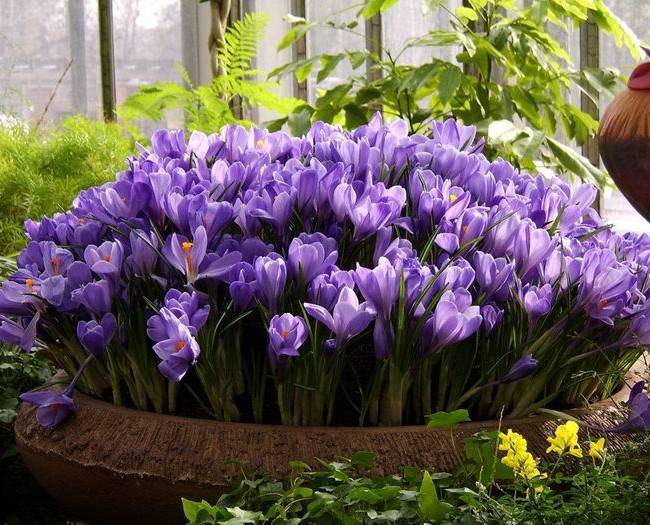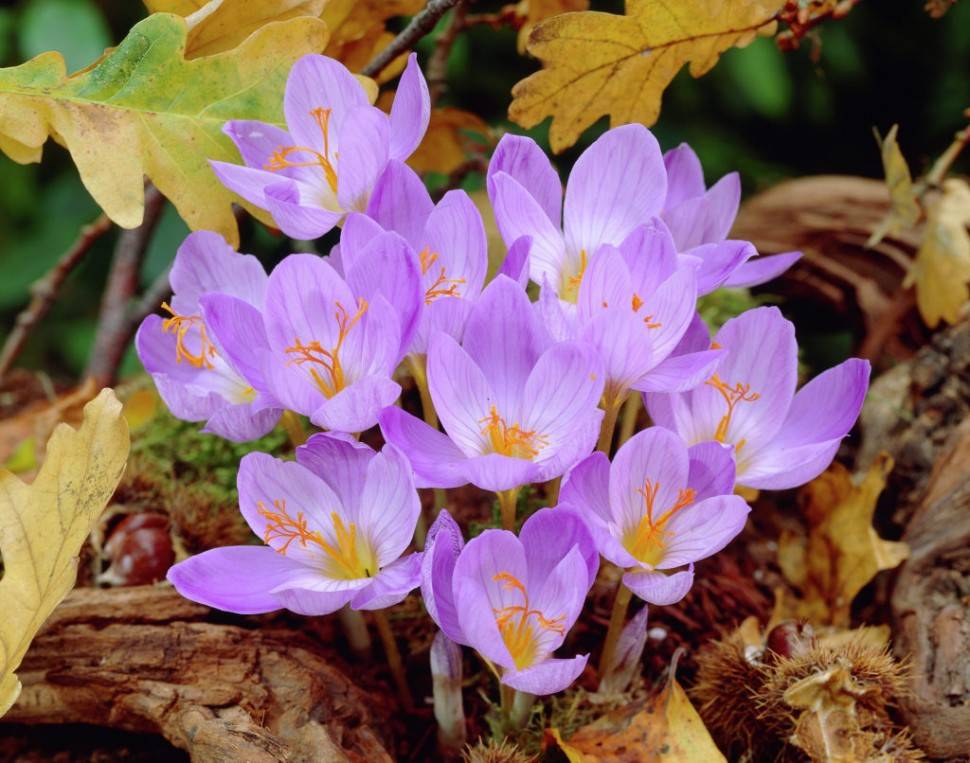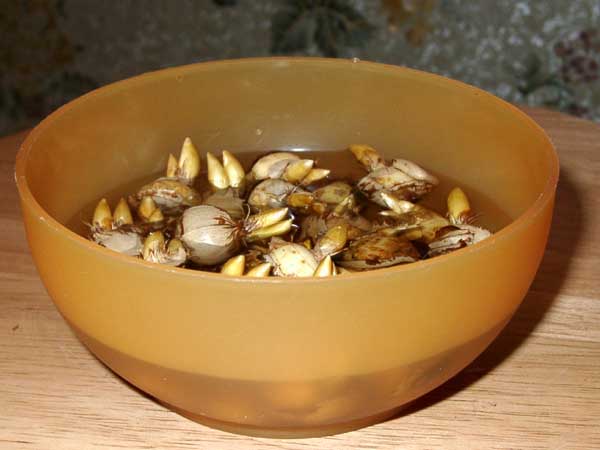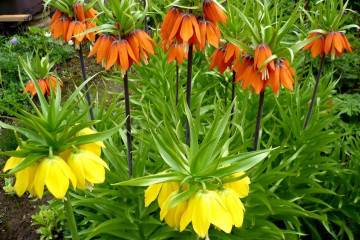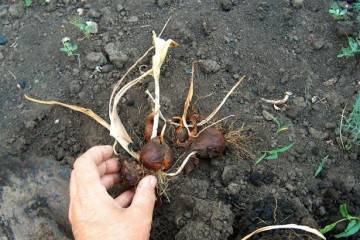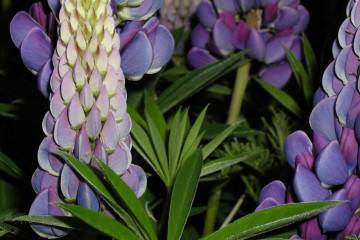When to dig up crocuses - transplant to a new place
Content:
The first flowers that appear after the winter cold cannot but rejoice. By knowing how to plant and replant crocuses in your garden, you can grow beautiful primroses.
General information about the crocus plant
Crocus stems are rarely longer than 10 cm. Slightly flattened, scaled bulbs of the culture reach a width of no more than 3 cm. The roots are small, fibrous. The shoots are narrow, elongated in length, arranged in the form of a bundle emerging from the middle of the onion.
Crocus flowers are located singly, have a goblet shape, when fully opened, they are rarely larger than 5 cm in diameter. The color of the flowers can be cream, rich or pastel purple, bright yellow, snow white, pale blue, dark purple or orange. There are varieties with two-color or spotted petals.
Growing crocuses: features
The bulbs can be planted outdoors or in flower pots at home. The main thing is to comply with some of the requirements that are mandatory when growing crocuses:
- The flower needs good lighting, but at the same time protection from direct sunlight and gusts of cold wind.
- The acidic reaction of the soil at the planting site should be neutral. The structure of the soil requires light, loose, well-drained.
- The plant is unpretentious to the quality of the soil, but during germination and flowering, it is advisable to feed the bulbs with phosphorus and potassium.
- The plant easily tolerates a lack of moisture, excessive moisture is even dangerous for it, since the bulbs are easily infected with fungal diseases.
Knowing about such features and adhering to them, you can safely plant these cute flowers on the site or on the windowsill.
Ideal time to harvest bulbs
A plant transplant is necessary, it is only important to know when to transplant crocuses to a new place.
Cleaning weather
Autumn varieties take a break from flowering from June to August, spring varieties from July to September. This is the best time to dig up crocuses. The work is devoted to a cool day without precipitation.
Step-by-step process for digging up the bulbs
When the crocuses have faded, what should a gardener do? They must be removed from the ground using a pitchfork. The procedure is as follows:
- A litter is placed next to the planting.
- Having stepped back a little from the bushes, the pitchfork is immersed in the soil to its full depth and pushed together with an earthen lump.
- The bulbs are taken out of the coma laid out on the litter, each is thoroughly cleaned. The roots are cut with pruning shears.
- The bulbs are placed in a box in one layer, transferred to a shaded place and dried for several days.
Dried crocuses will need to be further processed before being sent for storage until next season.
Varieties that don't need to be dug up in the fall
Conventionally, the varieties of this plant can be divided into flowering in early spring and forming buds in October-November. It depends on this when to dig up crocuses after flowering. Among the varieties blooming in autumn are:
- The Sharoyan variety opens up bright lemon-colored corollas after mid-September.
- The sowing plant, which has rather large purple flowers, blooms closer to October. Its dried stigmas are used as spices.
- The beautiful crocus belongs to the early flowering autumn varieties. It begins to form large white and lilac buds at the very beginning of September.
- Banat crocus looks like lilac irises. Blooms during September.
How to properly prepare bulbs for storage
Having dug up crocuses after flowering, what to do next? They are dried during the day and processed. Only in this case it will be possible to transplant crocuses in the next season without any problems, as planned.
Drying and sorting tubers
Bulbs are examined, discarded damaged, moldy, showing any signs of ill health. Healthy onion scales should be dry and free from spots or discoloration.
How to store bulbs at home
You can store crocus bulbs in a cool (15-18 ⁰C) room with good ventilation. It is forbidden to place tubers in plastic bags or keep in a common heap, stuffed into one container.
How long can an onion be stored
Planting material can be stored under optimal conditions for no more than 2 years. If it was not possible to plant the bulbs with the onset of the new season, then they should be sorted out and processed again.
Storing tubers in the ground
It is recommended to use boxes made of cardboard, plastic or wood with openings for air access as containers. A drainage layer and sandy soil are poured at the bottom, into which the onions are placed.
Balcony storage
When sending crocuses to be stored on a glazed balcony or loggia, you need to be sure that the temperature there does not drop below 0 ⁰C and does not rise above 18 ⁰C. Otherwise, the seed may freeze or rot.
In a dry basement with a temperature of 10-15 ⁰C, the bulbs are laid out on racks.
Cold storage
When crocuses have faded in the spring, what to do with them next? For summer storage, the bulbs are wrapped in paper and laid out in the vegetable compartment of the refrigerator. Crocus containers and pots can also be placed on the bottom shelf until it is time to plant.
Treatment of tubers from diseases and pests
To combat pests and diseases, you should carefully monitor the plantings of crocuses. At the slightest sign of ill health, the flowers are treated with the appropriate fungicides and insecticides.
To prevent the development of diseases, the crocus bulbs are sprinkled with wood ash after sorting. Before this, as well as directly replanting, they are etched with a weak solution of potassium permanganate.
Pest infestation during storage
Rodents love to feast on juicy crocus bulbs. When stored openly, all collected planting material may die from them.
To protect the bulbs from rodents, they are placed in 1 layer in a glass container with a lid that has small slots. To make sure that crocuses are protected, including from diseases and the onset of premature flowering, they should be examined once a month and the spoiled ones should be removed.
Observing the described technique for collecting and storing crocuses, you can achieve their abundant flowering in due time. The efforts made will pay off handsomely.

